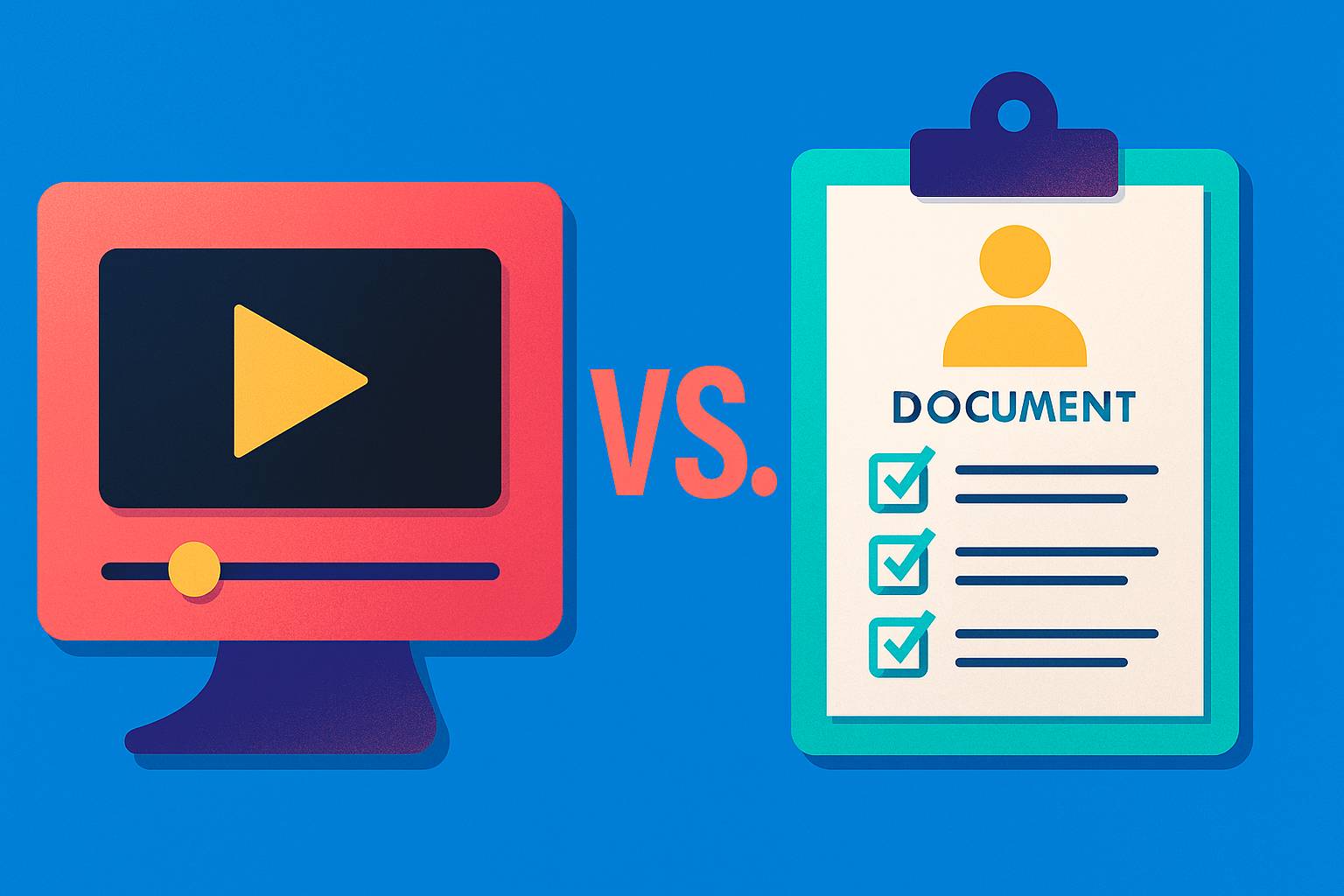Still sending onboarding PDFs and hoping new hires actually read them?
You’re not alone. But it’s costing you clarity, time, and retention.
According to Gallup, only 12% of employees say their company does onboarding well.
The problem? Format fatigue. Static docs get skimmed, not understood.
Videos help, but they’re often too rigid; no search, no questions, no updates.
In this guide, we compare video vs. document onboarding, and show you what actually drives faster ramp-up and fewer HR tickets.
By the end, you’ll know the format that not only lands, but converts.
Why Onboarding Format Matters More Than You Think
Most companies obsess over what to include in their onboarding content: company history, policies, tools, benefits, and team intros. But few stop to ask how that information is delivered. And that’s where things start to break.
Let’s be blunt: if your onboarding lives in a PDF, a wiki, or a wall of Slack messages, there’s a good chance it’s being ignored, skimmed, or misunderstood.
Here’s why format matters:
- Attention spans are short. New hires are overwhelmed. They’re navigating tools, learning acronyms, and trying not to feel like the new kid. If the format isn’t engaging or intuitive, they check out.
- Comprehension depends on context. Policies, benefits, and systems can’t just be “read”. They need to be understood. One-size-fits-all documents don’t work for all learning styles.
- Repetition burns your team out. HR teams spend hours answering the same questions that should’ve been clear in the original doc because the doc was too long or unclear to begin with.
And the cost? It’s real.
- 69% of employees are more likely to stay with a company for three years if they experience great onboarding.
- Bad onboarding leads to lower productivity, higher support loads, and slower time-to-value (TTV), especially in remote and distributed teams.
So no, format isn’t a footnote. It’s a core part of your onboarding funnel.
Next, let’s break down the pros and cons of each format, starting with the one most teams default to.
Don’t Miss: Turn SOPs Into Interactive Training: A Guide for HR Teams
Document-Based Onboarding: Familiar But Flawed
For decades, documents have been the go-to onboarding medium. Handbooks, Google Docs, PDFs, internal wikis, they’re everywhere. And for good reason.
Why Teams Still Use Documents
- Easy to create and update. Anyone can spin up a Google Doc or export a PDF. No design or production time required.
- Scalable. You can send the same resource to 10 or 10,000 employees without extra cost.
- Reference-friendly. They’re great for housing detailed policies, compliance info, and SOPs employees may need to revisit.
But here’s the flip side.
Why Documents Alone Fall Flat
- They get ignored. Just because it’s shared doesn’t mean it’s read. Or understood.
- No interactivity. You can’t “ask” a document to explain something differently. There’s no feedback loop or clarification layer.
- Skimming ≠ comprehension. Long paragraphs and legalese make critical content feel like a wall of noise.
- Support tickets skyrocket. HR and team leads get pulled into the same repetitive questions because documents fail to deliver clarity on their own.
Think about it. When’s the last time you read a 20-page onboarding PDF start to finish?
That’s not a knock on documents themselves. It’s a wake-up call that the format needs help. The good news? That’s where video comes in.
Video-Based Onboarding: Engaging But Limited
When it comes to engagement, video feels like the obvious winner. It’s dynamic. It’s visual. It feels personal. And for many companies, it’s become the go-to answer to the “people aren’t reading the docs” problem.
And they’re not wrong entirely.
Why Video Onboarding Works
- Boosts comprehension. People retain 95% of a message when they watch it in a video vs just 10% when reading it in text.
- Humanizes your brand. A welcome message from the CEO, a product walkthrough from a peer; these build trust and reduce friction.
- Great for remote teams. Asynchronous video helps new hires feel connected and informed, no matter the time zone.
But video has a dark side; especially when it’s treated as the only onboarding format.
Why Video Has Limits
- It’s not searchable. Need to revisit that benefits explanation? You’re scrubbing through a timeline hoping to find the right minute.
- Hard to update. New policy change? That means re-recording and re-editing, and that’s assuming you even have the bandwidth.
- One-way only. A video doesn’t answer follow-up questions. It talks at you, not with you.
Just like documents, videos do part of the job well but leave gaps when it comes to interaction, personalization, and flexibility.
So, if documents fall flat, and videos alone aren’t enough, what actually converts?
Let’s find out.
Also read: Why Interactive Docs Outperform PDFs in Driving Conversions
Which One Converts Better?
If you’re hoping for a one-word answer, “Video” or “Document”, you might be disappointed.
Because the truth is: neither format, on its own, is built to convert.
- Documents give depth, but lack delivery.
- Videos bring energy, but lack interaction.
They each solve one part of the onboarding puzzle but fall short when it comes to true understanding, self-service, and retention.
What Converts Better Is a Hybrid:
An onboarding experience that combines the best of both worlds:
- Narrated explainers that walk through key content like a video.
- Built-in Q&A that lets users ask clarifying questions in real time.
- Searchable transcripts that turn video into a navigable resource.
- Interactive touchpoints that guide, test, and reinforce knowledge.
That’s not a fantasy. It’s what modern tools like Docustream enable today.
The better question isn’t: “Video or Document?”
It’s: “How can I make my onboarding content actually work?”
In the next section, we’ll show you exactly how that’s done.
What If Your Onboarding Docs Could Talk Back?
Imagine this: your new hire opens a welcome doc, clicks “play,” and hears a friendly voice walking them through what they need to know. They get to ask follow-up questions. Search any part of the content. Even get clarity in real time without pinging HR or their manager.
That’s exactly what Docustream delivers.
Turn Any PDF, Doc, or Slide Deck Into an AI-Powered Onboarding Assistant
With Docustream, you can upload your existing materials like:
- Employee handbooks
- Policy guides
- Product training docs
- Benefits explainer PDFs
And in seconds, they’re transformed into:
- Interactive explainers with humanlike voiceover
- Searchable Q&A that adapts to every new hire’s questions
- Trackable insights so you know what’s working (and what’s not)
Why HR and Enablement Teams Love It:
- Employees actually finish onboarding. No more guessing if they read the doc. You can see what they asked, where they dropped off, and what they understood.
- Time-to-value drops fast. New hires get answers instantly, without waiting for someone to respond.
- Support tickets go down. Repetitive questions disappear when the doc itself answers them.
It’s onboarding that explains itself and it starts with the content you already have.
Real-World Comparison: Interactive Explainer vs Static PDF
Let’s walk through two onboarding scenarios. Same content. Different format.
Scenario 1: The Traditional Approach
- HR sends a welcome email with a 25-page PDF.
- The new hire opens it and skims the first few pages.
- They have a question about the benefits window but there’s no one to ask.
- They Slack their manager. Waits for a reply. Forgets to come back.
- A week later, they’ve barely onboarded and HR follows up manually.
Result?
- Low completion.
- Repetitive questions.
- Frustrated new hire.
Scenario 2: The Docustream Approach
- HR sends a welcome doc turned into a video explainer.
- The new hire hits “play” and listens while following along visually.
- They ask, “When do benefits kick in?” the assistant answers instantly.
- They search for “remote work policy” and jump to the exact section.
- HR gets insights into what was viewed, asked, and clicked; no follow-up needed.
Result?
- Higher engagement.
- Zero clarification emails.
- Faster onboarding, less lift.
This isn’t theoretical. Teams using Docustream have already cut onboarding ramp times and reduced internal support loads with just one converted document.
So if your onboarding flow feels like it’s stuck in 2010, maybe it’s time to try something smarter.
Key Takeaways: Choosing the Right Onboarding Format
If you take away one thing from this post, let it be this:
It’s not document vs video. It’s document plus video made smarter.
Let’s break it down:
| Format | Strengths | Weaknesses |
|---|---|---|
| Documents | Easy to scale, great for detail and reference | Often ignored, not interactive |
| Videos | High engagement, human touch | Hard to update, no Q&A or search |
| Interactive Explainers (like Docustream) | Combines narration, search, Q&A, and analytics | Requires initial setup (we help with that) |
What should you do?
- Keep documents for depth, but don’t assume people read them.
- Use video for storytelling, but don’t rely on it for clarity.
- Adopt interactive formats when you want people to engage, retain, and act.
Whether you’re onboarding new employees, customers, or partners, the most effective experience will be the one that guides users, answers questions, and adapts to their pace.
And that’s exactly what Docustream makes effortless.
Try It for Yourself
Still not sure if your onboarding format is holding you back?
Here’s an easy way to find out:
Let us turn one of your existing onboarding docs into a smart explainer for free.
You send us a doc.
We’ll send you back a fully interactive, AI-powered version that:
- Plays like a narrated video
- Answers questions in real-time
- Is searchable and trackable
- And actually gets used
It takes less than 24 hours to see the difference.
Ready to make your onboarding work harder and convert better? Book your demo here
FAQs
1. What is document-based onboarding?
Document-based onboarding involves using static materials like PDFs, Google Docs, or internal wikis to train and inform new hires or customers during their initial experience with your company.
2. What is video-based onboarding?
Video onboarding delivers onboarding content through pre-recorded or animated videos, often covering company overviews, tool tutorials, or policy walkthroughs. It’s typically used to boost engagement and reduce support dependency.
3. Which onboarding method is more effective: video or documents?
It depends on the goal. Documents are useful for detail and reference, while videos increase comprehension and engagement. The most effective approach combines both, especially when interactivity and real-time support are layered in.
4. How does Docustream improve onboarding content?
Docustream transforms your static onboarding docs into AI-powered explainers with voiceovers, searchable Q&A, and usage analytics, giving new hires a self-guided experience that boosts clarity and retention.
5. Can I use Docustream with existing PDF or Word documents?
Yes. Just upload your onboarding materials in PDF, Word, or even PowerPoint format, Docustream will instantly convert them into interactive, video-style explainers.
6. What’s the benefit of making onboarding content interactive?
Interactive onboarding helps new hires engage with content actively, ask questions in real time, search for answers, and retain information better, all of which shorten ramp time and reduce support load.
7. How do I know if my onboarding is working?
Track metrics like content completion rates, support tickets, time-to-productivity, and employee satisfaction. Tools like Docustream also show you engagement stats and common Q&A trends.
8. What’s the easiest way to test if interactive onboarding works?
Start with one existing document like your company handbook or benefits guide and turn it into a Docustream explainer. You’ll see the difference in engagement and clarity within days.
9. Is interactive onboarding better for remote teams?
Absolutely. Remote teams rely heavily on self-serve materials. Interactive explainers ensure consistency, clarity, and accessibility without needing live trainers or constant follow-ups.
tl;dr
- Document based onboarding is scalable and familiar but often ignored, hard to engage with, and non-interactive.
- Video onboarding is more engaging and human but it’s not searchable, hard to update, and doesn’t answer follow-up questions.
- Neither format converts well on its own. The real winner? A hybrid approach that blends explainer video, Q&A, and search.
- Docustream lets you turn any static doc into an AI-powered onboarding experience, complete with voiceover, real-time Q&A, and engagement tracking.
- You can try it now by uploading one onboarding PDF or policy doc and we’ll turn it into a smart explainer. No learning curve required.
- Better clarity. Faster ramp-up. Fewer tickets. That’s onboarding that actually converts.
- Book a 20-minute pilot walkthrough and see how it works with your content.













